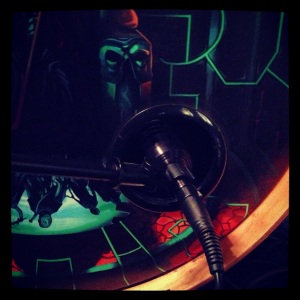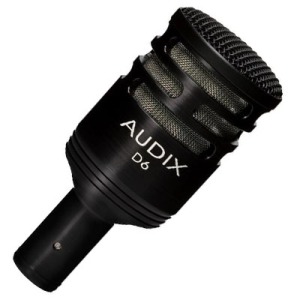 Our kick setup was real simple: 1 mic, 1 trigger. Last time we recorded, I used a second mic on the outside of the kick in an attempt to capture more body. Unfortunately, it just made the kick boomy, and I had much better results muting the 2nd mic, using a subharmonic enhancer on the 1st mic, and then blending in some kick samples to get more click and attack. This time, I discarded the 2nd mic altogether and added a trigger.
Our kick setup was real simple: 1 mic, 1 trigger. Last time we recorded, I used a second mic on the outside of the kick in an attempt to capture more body. Unfortunately, it just made the kick boomy, and I had much better results muting the 2nd mic, using a subharmonic enhancer on the 1st mic, and then blending in some kick samples to get more click and attack. This time, I discarded the 2nd mic altogether and added a trigger.
Luckily, it doesn’t take much to get a kick sounding good. It helped that the kick was nice and punchy and sounded good in the room to begin with, but that goes for all drums. If it doesn’t sound good by itself, it’s certainly not going to sound good (or better) once it’s under the microscope of multiple microphones.
 So, I mic’d the kick just inside the hole, pointing the mic at the spot where the kick pedal beaters hit the head. If you go too far into the drum, you’ll get more click/attack — sometimes that’s necessary for really fast double kick parts, as too much low end will make it sound bloated and messy. For this particular kick, it’s more of a big meaty sound with not as much click, so I opted to capture as much of the body as possible while still getting some of the click. I used an Audix D6 kick mic and placed it about halfway into the kick drum.
So, I mic’d the kick just inside the hole, pointing the mic at the spot where the kick pedal beaters hit the head. If you go too far into the drum, you’ll get more click/attack — sometimes that’s necessary for really fast double kick parts, as too much low end will make it sound bloated and messy. For this particular kick, it’s more of a big meaty sound with not as much click, so I opted to capture as much of the body as possible while still getting some of the click. I used an Audix D6 kick mic and placed it about halfway into the kick drum.
Since we have some moderately fast double kick parts in the songs, I needed a preamp with a fast transient response that wouldn’t fart out or smear the signal when things picked up the tempo. I tried a few preamps (UA 4710-d, Neve 1073 clone, UA LA-610) but ended up going with the API 512c. It sounded best and had everything I needed, which is punchiness and fast transient response.
 I also used a trigger on the batter-side of the kick. Triggers, for those who aren’t aware, are actually just tiny piezo microphones that mount to the head of a drum and only pickup the actual drum hits. This signal is recorded onto a separate track and can be used for triggering noise gates, sidechaining compressors or for triggering drum samples. I use them for all three purposes. In this particularly instance, the background noise is low enough that I don’t need it for gating — I can gate just on the actual mic signal since the kick hits are far louder than any other sound captured by that mic. My main use for the kick trigger is sample blending.
I also used a trigger on the batter-side of the kick. Triggers, for those who aren’t aware, are actually just tiny piezo microphones that mount to the head of a drum and only pickup the actual drum hits. This signal is recorded onto a separate track and can be used for triggering noise gates, sidechaining compressors or for triggering drum samples. I use them for all three purposes. In this particularly instance, the background noise is low enough that I don’t need it for gating — I can gate just on the actual mic signal since the kick hits are far louder than any other sound captured by that mic. My main use for the kick trigger is sample blending.
Neither the drummer nor myself particularly like sample replacement, where you completely replace the sound of the drum, but we also recognize that it’s hard to get a ‘modern metal’ drum sound just using the natural kit. So, we’ve decided to blend samples in with the natural acoustic sound. We’ve tuned the drums to sound as heavy and punch as possible, and then we’ll use EQ and blended samples to augment the sound and get it where we want it to be. For this kick, since it has so much punch and meat/body already, we’ll most likely just blend in a really clicky kick sample to help it cut through the mix. This will be further down the line when we start mixing.
